SNG was recently asked by residents from a neighborhood just outside Nashville, Tennessee, where to best put their efforts to get connected with broadband. They have lived in a location for 10 years and it is not serviced with high-speed internet even though they are near where it stops on either end of their community. Asking the incumbent providers in their words “has proven futile” to getting better service. However they have many neighbors who would be interested in better internet service because many have businesses and work from home and they don’t want to move.
At SNG, we understand this challenge, which too many residents and businesses face across North America because of their perceived addressable market, expected revenues vs. cost to service their market, low density, etc. Approaching private sector providers can be ‘futile’ if those providers do not see enough of a business case to invest in your area and when providers have better returns elsewhere.
The challenge to get broadband deployed in unserved or underserved areas is to enable a positive case for investment. Driving awareness and utilization of broadband with local residents and businesses drives local economic growth and community benefits – which makes a case for public investment to bridge broadband gaps.
Two Options Going Forward
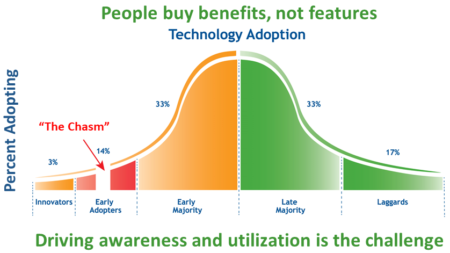
There are generally two options going forward – either 1) a public-private-partnership to entice a broadband provider to deploy in your area by subsidizing their business case; or, 2) build your own digital infrastructure which multiple providers can then use to provide services (like municipal roads which are built, owned and maintained by the municipality, but anyone can use them).
Subsidizing a Service Provider’s Business Case
If you choose to subsidize a provider’s business case to bridge their gap between their costs and their expected returns on capital, then local dollars should be used to build infrastructure that the locality owns (like a tower, backhaul fiber, etc.). This retains local ownership and negotiation capability which may be needed if there is poor broadband service because the provider is exercising a market dominant position. Retain ownership and control of your digital future.
In working with providers, there is also the option of conducting a broadband demand assessment to identify people ready to sign-up to new service, as well as assess potential demand for online services. This is local market demand research. Private sector providers are often reluctant to spend their retained earnings on such research, especially if they are unsure there is a business case for them. By quantifying current and potential broadband demand up-front and sharing that with private sector providers, they can apply that data to their business models to see if there is a business case for them that previously ‘flew under their radar’. Having a contact list of people who are ready and committed to sign-up makes that business case for the provider even stronger.
In both these broadband public-private-partnership instances, local funds subsidize one service provider. This may be a tactical, less complicated, and a less involved way for a locality to move forward – who in their right mind would want to take on more work, especially a broadband initiative! However, performance agreements should be negotiated and periodically reviewed to ensure local residents and businesses are getting the broadband they need – and want.
Investing in Digital Infrastructure
The other approach is the locality investing in their own digital infrastructure which is more involved, more complicated, and longer term. But this approach addresses the issue of local ownership and control of essential infrastructure – as with other infrastructure like roads, or electrical where community benefits are significantly greater than a private sector business case. At SNG we call this the economic case for investing in broadband. The example of Ammon, Idaho, proves that it is possible for a locality to own their digital future while also allowing multiple providers to provide competitive, robust internet services that meet the needs of local residents, businesses, and organizations.
Deciding where and how to get started depends on the addressable market of the locality (i.e. broadband market potential), the local champions available to drive the process, the local organizational capacity to support a broadband initiative, and whether local residents, businesses, and organizations (government, education, health) have an understanding and vision of how they can benefit from using online practices. The table below outlines a roadmap to get started with broadband and SNG’s suite of services that have been designed to help you make the right decisions based on your needs and circumstances, no matter what stage you are at in the process.
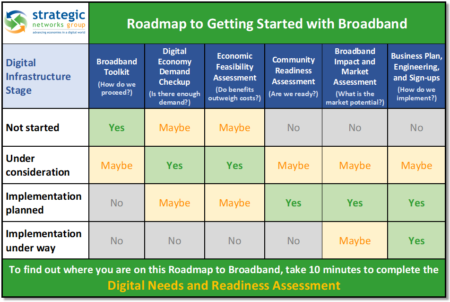
Where and How to Get Started with a Broadband Initiative
If you are interested in assessing at what stage your locality is in the process of getting broadband – because it is a process – we have the Digital Needs and Readiness Assessment that your local broadband champion can take online. When they completed the 10 minute online survey, a report will be generated and automatically be emailed to them. We developed this tool specifically to help local leaders understand at what stage their locality is and to help them prioritize their community goals and priorities. SNG’s goal with this is to help local leaders make better informed decision on how they can and need to move forward in a way that is pragmatic, clear, and cost-effective.

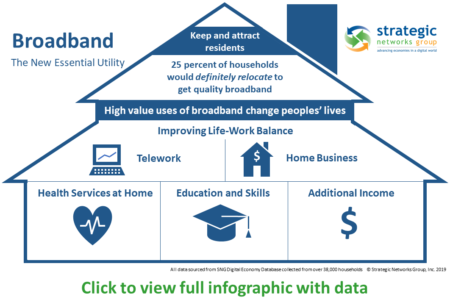 SNG Research Brief – Household Broadband
SNG Research Brief – Household Broadband
Access to robust and competitive broadband is essential for any community to survive, let alone thrive. Unserved or underserved areas continue to exist in many localities, whether because of limited or no choices for service providers, outdated technology, etc. This research brief provides some insights and data points on the current state of access for households, with focus on rural communities and how they compare to urban areas.
From SNG’s research of over 19,000 households across the North America we are able to reveal some of the important findings that proponents of broadband need to know. These insights are from household data collected directly by SNG rather than statistics provided by service providers or other agencies.
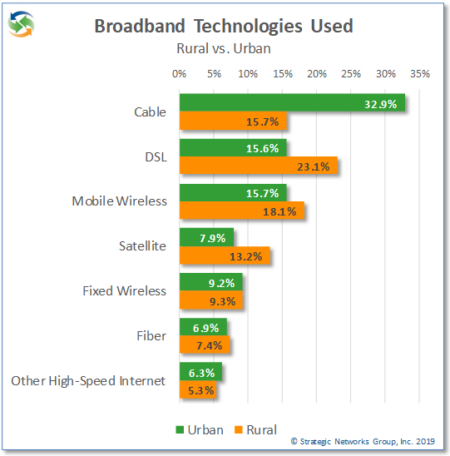
Technologies used
While fiber deployment and use are increasing, cable remains the dominant broadband technology overall with 23.6% of households, followed by DSL at 19.6%. However, the picture changes when you compare urban and rural areas.
While cable dominates urban markets, DSL is still the most used technology in rural areas – which suggests that this is due to the lack of other available options. Fiber use is low for both urban and rural households. For rural areas in particular, the lack of cable and fiber options drives up the use of mobile wireless and satellite as an alternative.
Broadband Service Priorities and Satisfaction
From a user perspective, technology is only relevant for its impact on connection speed, reliability, and price. Understandably, much emphasis is put on speed of connection, since this is how services are sold. However, when it comes to how households prioritize their selection of service, reliability is cited as highest priority with 88% of households compared to 77% who say speed is a high priority and 66% who say affordability is a high priority. These priorities are almost identical between rural and urban households.
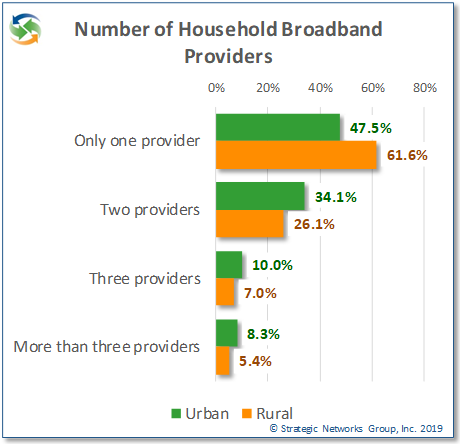 So, if that is what households expect, then what is available and how do they feel about the connections they have?
So, if that is what households expect, then what is available and how do they feel about the connections they have?
More than half (54%) of households have only one broadband provider available, clearly indicating a lack of choice for most households. For rural areas nearly 62% of households have only one broadband provider to choose from, with implications for competitive service price and quality.
This is reflected in rural service speeds, price, and satisfaction. On average, rural households get approximately half the download speed as urban households and just over one third the upload speed. When it comes to meeting current FCC speed recommendations, 28.7% of urban households meet or exceed the recommended 25 Mbps download and 3 Mbps upload speed, while only 17.2% of rural households do so. Even looking at the old FCC recommendation of 10 Mbps down and 1 Mbps up, just over one third of rural households meet those speeds.
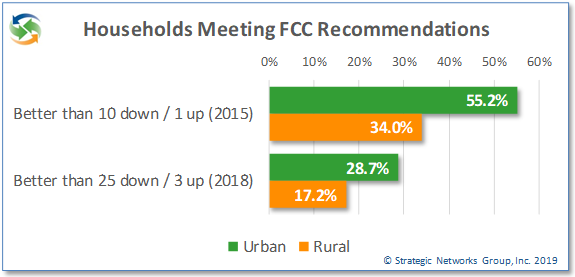 More than 61% of rural households get less than 10 Mbps download speed for an average cost of $70 per month. Overall, rural households pay a monthly cost of $4.38 per MB compared to $2.32 per MB for urban households, almost double the cost. Rural households have less choice and slower speeds and spend more for the same or poorer service.
More than 61% of rural households get less than 10 Mbps download speed for an average cost of $70 per month. Overall, rural households pay a monthly cost of $4.38 per MB compared to $2.32 per MB for urban households, almost double the cost. Rural households have less choice and slower speeds and spend more for the same or poorer service.
As a result, 70% of rural households subscribing to less than 10 Mbps download speeds are dissatisfied with the value of 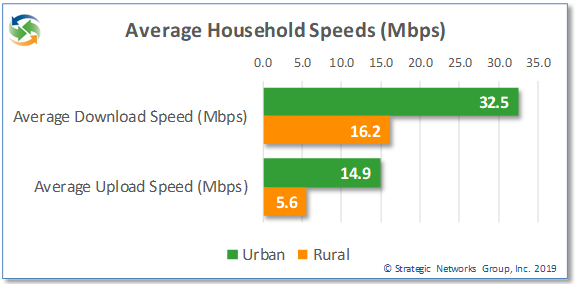 their service for the price they pay, and 69% are dissatisfied with the speed of service. In addition, 64% of households are dissatisfied with the reliability of their service. The satisfaction levels are only slightly better for urban households with less than 10 Mbps download, with 68% dissatisfied with value, 58% with speed, and 68% with reliability.
their service for the price they pay, and 69% are dissatisfied with the speed of service. In addition, 64% of households are dissatisfied with the reliability of their service. The satisfaction levels are only slightly better for urban households with less than 10 Mbps download, with 68% dissatisfied with value, 58% with speed, and 68% with reliability.
This is partly explained by the different mix of technologies deployed in rural areas. With a higher proportion of DSL and satellite connections used in rural areas the quality of speed and reliability is reflected in overall satisfaction levels, resulting in lower satisfaction with value for the price of the 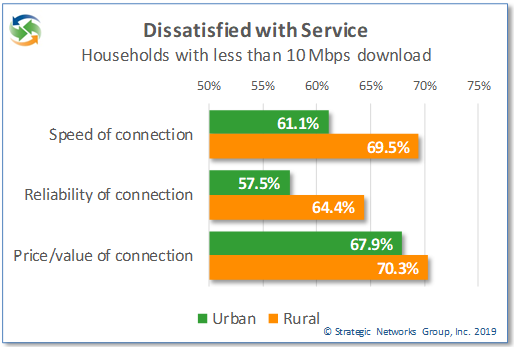 service. Fiber connections generate the highest satisfaction levels by far, followed by cable service. Very few households are fully satisfied with DSL or satellite services, and yet for some these are their only options for broadband connectivity.
service. Fiber connections generate the highest satisfaction levels by far, followed by cable service. Very few households are fully satisfied with DSL or satellite services, and yet for some these are their only options for broadband connectivity.
34.7% of households say that their fiber connection is “worth every penny” for value satisfaction, compared to 7.6% for cable, 4.6% for DSL, and 2.0% for satellite. Another 48% say the value of fiber is “acceptable for what I pay”, versus 38% for cable, 27% for DSL, and 15% for satellite. Similar satisfaction levels by technology are shown for connection speed and reliability. More than any other technology, fiber is clearly a solution that meets household priorities and expectations.
The Implications for Households and Communities
Households without good broadband available to them may choose not to take any of the options forgoing the speed and reliability they need. Households in this situation will not use the internet to its fullest capacity, missing opportunities for them to fully benefit from what the internet can offer – such as new income opportunities, remote access to health care and education. This negatively impacts community well-being as inadequate broadband risks losing population and difficulty in attracting new residents and businesses. This is particularly challenging for smaller, rural communities where SNG research has shown that they are more likely to lack quality broadband and have the most to lose in terms of population decline, especially among youth.
See how a rural county got the support and funding to build the digital infrastructure they need to thrive – Custer County Broadband Impact and Market Assessment.

Find out more about SNG Solutions for Local Economic Development.

by Michael Curri & Doug Adams
In work across four American States, SNG research has found that not all e-solutions are created equally. Some are relatively easy to drive adoption and utilization… some are extremely different and require overcoming great challenges. When we plot out the utilization of various e-solutions versus SNG’s proprietary Digital Economy index (DEi) which measures the utilization of broadband as a platform for innovation, we see just how hard in what we’ve dubbed our “football chart” below. As a reminder, DEi scores range from 1 to 10 (10 being highest), with higher scores reflecting the greater the number, scope and sophistication of the Internet activities deployed in an organization.
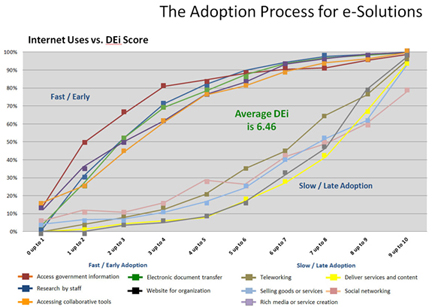
As we discussed last month – businesses with a high DEi, meaning higher levels of adopting and using e-solutions, experience larger percentage increases of revenues (between 27 and 31%). Increasing Internet utilization dramatically increases business revenues and job creation.
So what does this have to do with the football chart? Let’s dig deeper and look at what separates the more successful organizations in utilizing broadband, creating efficiencies and growing revenues. It’s not the easy, “quick to adopt” solutions that include accessing government information online, sharing files, using collaborative tools, online research, and companies hosting their own website. These are all basic and even unsophisticated businesses are doing these.
But what separates the mediocre from the great… who is “winning” according to SNG’s research and the ‘football chart?’ The organizations that take on the difficult challenges, the more complicated e-solutions, are the businesses that are utilizing broadband to grow their business. These include:
- Teleworking – Using the Internet as your “virtual office,” enabling a geographically disparate workforce.
- Rich media – Creating multimedia content and interactive tools to market products/services and increase sales opportunities
- Social networking – Using today’s social network forums to promote business and collaborate with peer groups and colleagues
- eCommerce – Selling goods or services online – this can include driving leads toward payment and does not require online payment.
- Deliver services or content online – From customer service departments to digitized products.
Are you focusing on simply providing broadband and waiting for people to adopt… and ultimately utilize e-solutions (the tried and failed build it and they will come mentality) or are you driving utilization? Focus on driving sophisticated use of broadband and you’ll see your region’s economy reap the benefits. SNG has helped to look at where gaps are and prescribe next steps for economic development through broadband in communities and regions.

Unanswered Questions, Unfulfilled Leadership
I was reading the other day about how firms in my homeland of Canada are filling the gaps left by the government’s decision to axe the long-form census. In this case, the newspaper (okay, not a real newspaper – the online version) described a firm that is collecting data about the workforce so that organizations can better understand how to attract and retain employees. This is a private sector firm collecting data to uncover what used to be provided by government agency Statistics Canada.
 What is this story really about? Is it about the private sector is naturally filling a void created by a government cutting programs? Or is this a story about how leaders need insights… decisions need background information, and strategies need guidance? Just because it is a cliché does not mean it is not true… Knowledge is Power. The best decisions are made with better information. The best strategies are based on market intelligence. And investments are best leveraged when you know where they can have the most impact.
What is this story really about? Is it about the private sector is naturally filling a void created by a government cutting programs? Or is this a story about how leaders need insights… decisions need background information, and strategies need guidance? Just because it is a cliché does not mean it is not true… Knowledge is Power. The best decisions are made with better information. The best strategies are based on market intelligence. And investments are best leveraged when you know where they can have the most impact.
Governments poised to compete in the 21st century global economy realize that to thrive, they need to be able to leverage the resources they have, make the right decisions, and provide their businesses with an ability to innovate and capture markets. Good planning requires insights into opportunities within the context of available resources and tools to overcome barriers.
Regions with governments that are cutting back on information gathering will not have the data and insights they need to create winning strategies and develop programs that foster growth. Without naming names, we all know of regions that are depressed and struggling more than others. What do most have in common? Weak or nonexistent strategies. And behind that, a lack of insights needed to succeed. So who will fill the void?
I founded SNG 12 years ago to help communities and regions make better decisions about their broadband investments and show them how to better leverage the networks for economic and social development. This requires assessing needs, benchmarking gaps, and helping regions plan strategically to shorten the path to desired outcomes and impacts. In essence, SNG is translating broadband into opportunities and jobs through fact-based economic strategies.
If you don’t measure, you can’t manage … and you surely cannot develop successful strategies that will give the stakeholders in your communities and regions what they need to compete and lead in today’s knowledge economy. Without intelligence and insights on where you are now as compared to where you want to be, you are forced to be a follower. In the globally competitive marketplace, it’s the innovators that will benefit from a high wage economy and with it, high quality of life.
SNG maximizes limited resources by identifying key economic levers on which to pull and we do this on a case by case basis. SNG can help get you the information you need for your own creative strategies from a region-wide standpoint. In addition, our DEi Scorecard can give you insights all the way down to the individual organization level. For example, businesses can receive individual reports to let your entrepreneurs know how they stack up against local and global competition and what they need to do to be more competitive.
SNG: The Broadband Economists
If you’ve been to out website in the past few weeks, you’ve seen some drastic changes.

Let’s start with our new tagline, “The Broadband Economists.” What, you may ask, does this mean? At its heart, SNG is a group of broadband economists who develop strategies for most effectively leveraging broadband investments. But what exactly is a “broadband economist?” Well it is not a bean counter or an abstract thinker who cannot apply theory into practice. We are economists in the sense that we are looking to help make the most broad-reaching and transformational impacts that broadband can bring enable businesses, communities and regions. Our goals: economic development, social advancement, increased productivity and competiveness.
Our website, www.sngroup.com, also has a new look and is much easier to navigate. Enhancements include new insights for broadband initiatives in blogs, articles, newsletter archives, etc. We’ve provided tips and success stories to help successfully navigate and manage successful broadband initiatives through the Broadband Lifecycle
We’ve taken great pains to help everyone, from elected officials to business professionals to technology experts, better understand the keys to successful, transformative, and economically impactful initiatives. Visit our site on a regular basis for updates and broadband news as we’ll be monitoring the broadband industry – and its best practices – to help to ensure your success.
A Fresh Look at the Digital Divide
by Derek Murphy
 A lot of funding is being invested in broadband infrastructure, which will bring high speed connectivity to many communities and regions around the world who previously did not have high speed access. As the number of communities without access to broadband declines, there will be room, both politically and financially, for other priorities. Within the context of the digital divide, what priorities need to be articulated and placed on the political and policy map?
A lot of funding is being invested in broadband infrastructure, which will bring high speed connectivity to many communities and regions around the world who previously did not have high speed access. As the number of communities without access to broadband declines, there will be room, both politically and financially, for other priorities. Within the context of the digital divide, what priorities need to be articulated and placed on the political and policy map?
For example, as planning and mapping efforts unfold across the United States, including our own SNG projects in North Carolina, Virginia, Louisiana, and Kentucky, more and more evidence is emerging of a shifting picture that is more complex than just “un-served” “under-served” and “served” as defined in the United States by the National Telecommunications and Information Administration. These relatively broad categories have played their role, but need to evolve if they are going to be useful for future planning efforts based on evidence that we have recently collected.
“39% of households would very likely relocate to another community if broadband was not available. Over 55% of organizations say that broadband is essential for remaining in their current location.” Recent SNG Technical Report for a designated State broadband authority.
Unserved communities: Recent SNG research shows that the vast majority of businesses and organizations (97 percent) have Internet connectivity. As a consequence, unserved communities are now primarily composed of residential areas, rather than whole communities that include business districts. In addition to the impacts on individual households, there are two significant dimensions to the digital divide faced by unserved communities. First, the higher the percentage of areas having broadband connectivity, the greater is the disadvantage experienced by the remaining unserved communities. e-Solutions Benchmarking data show a pronounced tendency of businesses and households to make decisions on where to locate based on the availability of high speed and reliable broadband. Second, a large percentage of economically active households use their home to generate income, either through teleworking or home based businesses. With economically active households making locational decisions with connectivity in mind, rural areas without broadband will lose economically active households, with major negative impacts on their long term sustainability.
Unserved pockets within served communities: SNG research has shown that these areas are primarily low density residential areas, usually rural and/or low income. Mapping efforts have been useful in identifying unserved communities but may be less effective at identifying the pervasive but smaller unserved areas within “served” communities. These low density areas provide a poor business case for infrastructure investments by current Internet Service Providers. Small areas are less likely to be the focus of infrastructure funding programs. As current efforts have their desired impact of reducing the number of unserved communities, it can be anticipated that a larger portion of unserved households will fall within this category of “unserved pockets within served communities.” Any strategy to address this aspect of the digital divide will necessarily be different from strategies used for unserved communities. The small scale and scattered nature of the target of population, together with the lack of institutional capacity, will require more imaginative approaches, either with incumbent ISPs or with small but agile wireless ISPs.
Uncompetitive Broadband: There already is significant recognition that much of the existing broadband infrastructure in North America consists of relatively low speed technologies. Fifty percent of the business respondents to a recent statewide SNG survey had upload speeds of less than 700kbps. Additionally, a significant portion of respondents indicated that they were unsatisfied with the speed and/or reliability of their broadband connection. This level of dissatisfaction can be expected to increase as reliance on Internet increases and the gaps between levels of service increases between highly served and poorly served areas.
While much of the current debate on “better broadband” focuses on improving speeds, the reliability issue should be considered as an equal or higher priority. Recent SNG surveys show that reliability and availability of redundancy are increasingly important to many businesses and organizations who state that the Internet is essential to their operations. For these organizations, availability of reliable service and redundancy will play an increasingly large role in their location decisions.
Over the few years, analysts and policy makers have used various terms to describe the need for “better broadband.” However, there remains the danger of using a simple threshold to determine whether a community or region has the desired level of Internet connectivity. A fundamentally stronger concept is that of “competitive broadband.” Competitive broadband recognizes that upgrades to infrastructure are required well into the future to maintain competitiveness globally and regionally. Without competitive infrastructure, businesses and people will quickly or slowly move to greener pastures.
Need for Mobile Broadband: while not the focus of this article, there needs to be acknowledgement of the growing role that mobile broadband plays. In SNG research, organizations and businesses state that mobile Internet is essential to their operations. The use of mobile devices and applications for “untethered access” is expected to continue to grow and become increasingly integrated into how organizations use the Internet. In planning and designing future broadband initiatives, care needs to be taken that the lack of mobile broadband doesn’t become the latest symptom of a digital divide.
As communities and regions absorb the impacts of recently announced broadband investments in infrastructure, planning and adoption, it will be important that we not remain stuck in the terminology and concepts that guided these investment programs. The very success of these investments will require us to evolve our analysis and planning.
As always, thank you for your continued support. If you have any questions or feedback, please don’t hesitate to get in touch!
Why communities need to put in place a solid support structure
Today, most people and businesses are computer literate, and aware of the Internet’s potential – at least in general terms: about 70% of households have a computer at home with some form of Internet access (increasingly broadband), many others have access to computers and the Internet at other locations (such as the workplace or school) and virtually every business uses computers and over 85% have Internet access. Many households and businesses don’t “use” broadband mostly because it is not available in their area. However that’s changing fast – as private and public investments help make broadband increasingly more available and adoption more straightforward. The proof: current research shows that US household broadband adoption increased from 55% to 63% in the past year, while dial-up Internet use dropped from 10% to 7% over the same period.
But this also means that up to 30% of households remain “unconnected” to the Internet – for a variety of reasons, including uncertain relevance, affordability, and availability. And, while connected to a greater degree, many small businesses face the same issues when it comes to broadband adoption.
What it is missing?
For many, it is a complicated matter: firstly understanding what broadband can do for them, and then understanding that it is worth doing, and finally understanding how to make it happen. Increasing the understanding of broadband relevance contributes to the adoption of broadband by new users and increases the “benefits” of broadband by those that have it.
But the truth is that sustainable broadband adoption requires more than simply making broadband available. We can call it a virtuous circle of sort: the way households and businesses use broadband – in ways that are relevant and beneficial to them – creates broadband value. This value increases not only the sustainability of network investments through increased revenues, but also increases the social and economic benefits for households, businesses and communities. The key is education and support: meaningful support at the local level (to educate and facilitate on how to get the most out of broadband) is essential to for the full value of broadband to be realized. Businesses themselves, especially SMEs (small and medium enterprises), recognize their need for support in a number of areas: understanding broadband and e-solutions benefits, assessing and selecting relevant e-solutions, and implementing and maintaining e-solutions. Over 70% of SMEs do not have the time or resources themselves and 65% would seek external support. However, 63% say that the lack of local external resources is a critical or challenging barrier for progress in adopting e-solutions.
Key role for communities
Intermediary organizations, such as community groups, economic development organizations, chambers of commerce, etc., can play a key role in reaching out to the community of broadband users. The fact is that communities that take an active role in building capacity locally to support broadband users achieve higher impacts from broadband availability. Local support must be driven by an understanding of the fact that what is good for business growth and retention is good for the local economy, and that adoption of e-solutions contributes to business success in a global economy. Whichever organizations play this role, local economic development needs to be the driver. For households, which are contributors to the local workforce, broadband offers new opportunities for education, skills development, employment, and home businesses. For businesses, broadband offers the means to transform their operations and open new business opportunities.
Broadband support 101
Business support can be provided in a number of ways, including: access to useful information resources and tools; workshops and seminars; and local collaborative approaches to sharing experiences and best practices on what is possible and how to stimulate innovation. Success breeds success, and contributes to a positive business environment. Households and individuals can also benefit from local outreach and awareness, including training at various levels through schools, libraries, and community access centers.
Measurable results
Measurable results Not only can these support activities benefit broadband users and encourage sustainable adoption, but they help retain direct investment in broadband initiatives within the community through public and private support services. Building local capacity for broadband creates direct local opportunities for youth and re-employment. Sustainable broadband adoption and the benefits this brings require investment in “people infrastructure” as well as technology infrastructure.
By Gary Dunmore, SNG
Click here to download this SNG position paper
If you think we can help, or would like to learn more about our broadband sustainable adoption services, please contact us.
… or why a ‘new angle’ is required to talk business owners into broadband
We are all connected now, aren’t we? Internet connectivity is simply an essential in a globally connected economy. Large enterprises know this, and have long had the wherewithal to integrate networked applications into their business operations. (At SNG, we talked about this integration as “e-solutions.”) Of course, the increasing availability of affordable broadband Internet access has opened up the same opportunities for small and medium enterprise (SMEs). So, why are many SMEs still unable or reluctant to take on e-solutions? We would like to share a few ideas.
Of course, there are always the (not so) early (by now) adopters. Where broadband is available, a good number of SMEs do not need a lot of convincing about the cost-benefit of taking service – whether it be via DSL, cable, fiber, or wireless access. For them, higher connection speeds speak for themselves: no need for a complex business case to prove that being able to do the same things faster and more efficiently improves productivity; or that having an affordable ‘always on’ connection can save on phone connection costs or expensive T1 circuits.
And beyond the day-to-day efficiencies, there are the things they couldn’t do before broadband, such as: the promotions company that couldn’t transfer artwork files quickly between its offices and remote contract artists and was spending a fortune on time and costs of transportation; or the precision machining company that needed to be able to receive and send complex drawings online simply to be “eligible” to bid for major clients’ business. In fact, SNG research shows that over 60% of SMEs rate broadband as very important for making everyday operations easier and allowing them to make more effective use of resources.
However, more than 50% of SMEs have not (yet) internalized how broadband can increase revenues, reduce costs, or evolve how they do business. Here is the real challenge: why are so many SMEs still not taking full advantage of what broadband can offer?
Answers
Looking “inside” the businesses themselves can help. Firstly, some business owners don’t recognize the benefits of broadband. When it comes to “technology and the connected economy,” they often “don’t know what they don’t know” – and they have limited time or resources to figure it out. And, if the case isn’t made in terms of savings, growth or competitiveness they don’t allow much time for convincing. Also, there is often an assumption by business owners that implementing e-solutions requires technical know-how, or is something a small business cannot afford to implement or maintain. In fact, our research tells us that over
two-thirds of SMEs view the cost of development and maintenance and their lack of internal expertise and knowledge as important barriers to adopting e-solutions.
A different angle
We believe that SME owner-managers need to be enlightened about the transformative effects of technology, and the significant benefits they could reap from jumping on the broadband train. Without the jargon, they need to be informed about what happens when technology intersects with business processes; when it becomes possible to do different things and do things differently – creating new operating models and new business opportunities. This is the e-solutions moment. Rather than about speed and bits, business owners should think about “any business activity that can leverage the power of the Internet.”
Beyond e-commerce, SMEs should get a stronger, better feel for the opportunities that connectivity offers to transform how they conduct business (increased market reach, easier processing of orders, cheaper product delivery, smoother – when done right – customer service and technical support, etc.). Business owners, especially those who don’t want to sell online, need to be told about the good news – that there are many affordable e-solutions available online for them – and solutions that don’t need to be complicated to have big impacts, such as: sales force management and CRM tools to more effectively generate revenue, collaborative networks to enhance internal and external interactions and sharing, online national and global supply chain networks to uncover new opportunities, or remote access and tele-working packages to extend out-of-office reach. And of course, because not all solutions are applicable (or important, or useful, or affordable…) for every business, owner-managers need support in navigating through the mass of information, and in figuring out the “what works for my business; what solutions are appropriate; where is the greatest benefit; what should be done first, and what later?” questions.
An important focus
We know because we have been there too: support organizations have long had a hard time convincing the reluctant owners to act. However, we believe that the time has come when many SMEs will be receptive to effective support to find that intersection between technology and their business that works for them – provided it’s done without adding excessive burden that detracts from their business focus. Because making such support available to SMEs is as important as making broadband available in the first place it is becoming an urgent priority for public policy. Let’s keep in mind that that SMEs are a key engine for employment and economic growth (95% of businesses have less than 50 employees). More SMEs adopting e-solutions, enabled by broadband, improves growth, productivity, and competitiveness, with positive effects not only for SMEs but also for their communities and the economy overall. After all, that’s what sustainable adoption is all about.
By Gary Dunmore, SNG
Click here to download this SNG position paper
If you think we can help, or would like to learn more about our broadband sustainable adoption services, please contact us.
This month we finish our three-part series covering the steps of the broadband lifecycle. In May we covered demand analysis and pre-planning while June’s discussion centered on strategy, investing, and building the network.
The last steps of the process to create a “platform for productivity, competitiveness and innovation” via broadband are both simple and complex, and the most critical step in the journey – driving usage.
Step 5: Awareness & Adoption Support
Upon the complex building or expansion of the network, we turn to the basics, in this case Marketing 101. Even the world’s best product or service has no chance without consumers learning about its availability. Likewise, if it is difficult or confusing to get their hands on your product/service, its most likely that consumers will just continue the status quo, never to adapt your offering, no matter how life-changing.
Your message should always focus on life changing the benefits of broadband – avoid a “features” discussion. No matter the product or service, consumers “buy” benefits. They want to know why and what will change in their lives… not how. Once your marketing has convinced consumers and businesses that they need/want the social and economic benefits of broadband, the “how” to get connected naturally follows.
SNG can help you drive utilization and with it, the effectiveness of your network and how do you get businesses and households to leverage the power of broadband. And with connections to broadband and e-solutions – your region reaps the rewards.
Step 6: Monitor Impacts and Outcomes
Critical to the ongoing success, sustainability, and funding for your expanding broadband network and efforts is measuring the direct community benefits. It is step six that validates the broadband investment decisions and the direct and indirect positive impacts. And with this validation comes compelling reasons for further investment in network expansion and upgrades and/ or additional adoption and awareness campaigns to increase benefits from a broader base of users. At the same time, measuring outcomes serves as a model for businesses and citizens to utilize broadband.
SNG can help you measure the impacts of your investment, its use, and the direct/indirect economic benefits. Make sure your investment is being used, promoting economic development – and where and how you can increase adoption.

Step “7”: Back to the Start
As your broadband network is an evolving asset, the Broadband Lifecycle begins again as you adjust your strategies to meet evolving needs. SNG helps identify and shore-up any gaps, resulting in continuing development, effectiveness, and impact.
The “Broadband Lifecycle” is SNG’s unique approach to each and every broadband initiative. Keeping it in focus will result in creating a platform for productivity, competitiveness and innovation” for your region rather than a network that may or may not be used.
Before we wrap up this issue of Bandwidth, a few words about smart grids. Before you tune out from this seemingly over-hyped and over-discussed topic, we’re with you – smart grids are not exactly the most exciting topic. While touting the need for smart grids, there seems to be a lack of discussion of the benefits.
Proponents of smart grids need to convey the benefits to drive awareness and adoption among businesses and households. Just like any broadband-enabled application, in order to drive adoption, change agents need to tell people why they should care and/or change their behavior – a “so what.” Smart grids are here, they are great… so what does that mean to me?
Driving awareness and adoption (Step 5 of the Broadband Lifecycle) seems to be a missing component in many of the early smart grid initiatives. And while finding the benefits that resonate for your audience is key to driving adoption – let’s not forget the first step – awareness. SNG’s recent studies show that the number of business owners and homeowners even aware of a “smart grid” falls under 5% of the population.

For those who do know the story of smart grids, the narrative seems to be closer to that of 1984’s “Big Brother” than 2010’s BP Oil Spill, creating more support than ever for the need for energy conservation and responsibility. So taking a look at smart grids from a perspective of a broadband-enabled application, how do we drive adoption among our different audiences?
The Pragmatist
There are a lot of reasons a pragmatist will like smart grids. Outages can be prevented through monitoring and proactive maintenance/repair of equipment as well as diverting energy to areas of need during peak demand.
The Environmentalist
Smart grids help reduce community carbon footprints – and help individuals spread out their energy consumption for conservation.
The Thrifty Consumer
Recently Baltimore Gas and Electric estimated that the average home owner will save $115/year by using a smart meter and effectively controlling the way that energy is being utilized. Many utilities are giving households the opportunity to earn “Negawatts” – which serve as credits that translate to refunds.
The Business Owner
Business owners for any size business can work with their utility to create a control for the disbursement of energy to their facilities and drive down costs. At the same time, by implementing smart grids community-wide, costly power outages like the one in Washington DC this week can be avoided.
So let’s get smart about smart grids, remember that just like all e-solutions, you need to drive awareness and adoption (even if government regulation forces adoption). At the end of the day, environmentalists and pragmatists alike will find smart grids a benefit to the community, with broadband once again enabling cost savings and – in this case – conservation.
 (Read the entire article by Gary Dunmore here)
(Read the entire article by Gary Dunmore here)
Today, most people and businesses are computer literate, and aware of the Internet’s potential – at least in general terms: about 70% of households have a computer at home with some form of Internet access (increasingly broadband), many others have access to computers and the Internet at other locations (such as the workplace or school) and virtually every business uses computers and over 85% have Internet access. Many households and businesses don’t “use” broadband mostly because it is not available in their area. However that’s changing fast – as private and public investments help make broadband increasingly more available and adoption more straightforward. The proof: current research shows that US household broadband adoption increased from 55% to 63% in the past year, while dial-up Internet use dropped from 10% to 7% over the same period.
But this also means that up to 30% of households remain “unconnected” to the Internet – for a variety of reasons, including uncertain relevance, affordability, and availability. And, while connected to a greater degree, many small businesses face the same issues when it comes to broadband adoption.
What it is missing?
For many, it is a complicated matter: firstly understanding what broadband can do for them, and then understanding that it is worth doing, and finally understanding how to make it happen. Increasing the understanding of broadband relevance contributes to the adoption of broadband by new users and increases the “benefits” of broadband by those that have it.
Continue Reading →

We are all connected now, aren’t we? Internet connectivity is simply an essential in a globally connected economy. Large enterprises know this, and have long had the wherewithal to integrate networked applications into their business operations. (At SNG, we talked about this integration as “e-solutions.”) Of course, the increasing availability of affordable broadband Internet access has opened up the same opportunities for small and medium enterprise (SMEs). So, why are many SMEs still unable or reluctant to take on e-solutions? We would like to share a few ideas.
| Of course, there are always the (not so) early (by now) adopters. Where broadband is available, a good number of SMEs do not need a lot of convincing about the cost-benefit of taking service – whether it be via DSL, cable, fiber, or wireless access. For them, higher connection speeds speak for themselves: no need for a complex business case to prove that being able to do the same things faster and more efficiently improves productivity; or that having an affordable ‘always on’ connection can save on phone connection costs or expensive T1 circuits. |
 |
| by Gary Dunmore |
 |
And beyond the day-to-day efficiencies, there are the things they couldn’t do before broadband, such as: the promotions company that couldn’t transfer artwork files quickly between its offices and remote contract artists and was spending a fortune on time and costs of transportation; or the precision machining company that needed to be able to receive and send complex drawings online simply to be “eligible” to bid for major clients’ business. In fact, SNG research shows that over 60% of SMEs rate broadband as very important for making everyday operations easier and allowing them to make more effective use of resources.
However, more than 50% of SMEs have not (yet) internalized how broadband can increase revenues, reduce costs, or evolve how they do business. Here is the real challenge: why are so many SMEs still not taking full advantage of what broadband can offer?
 |
Answers
Looking “inside” the businesses themselves can help. Firstly, some business owners don’t recognize the benefits of broadband. When it comes to “technology and the connected economy,” they often “don’t know what they don’t know” – and they have limited time or resources to figure it out. And, if the case isn’t made in terms of savings, growth or competitiveness they don’t allow much time for convincing. Also, there is often an assumption by business owners that implementing e-solutions requires technical know-how, or is something a small business cannot afford to implement or maintain. In fact, our research tells us that over |
two-thirds of SMEs view the cost of development and maintenance and their lack of internal expertise and knowledge as important barriers to adopting e-solutions.
A different angle
We believe that SME owner-managers need to be enlightened about the transformative effects of technology, and the significant benefits they could reap from jumping on the broadband train. Without the jargon, they need to be informed about what happens when technology intersects with business processes; when it becomes possible to do different things and do things differently – creating new operating models and new business opportunities. This is the e-solutions moment. Rather than about speed and bits, business owners should think about “any business activity that can leverage the power of the Internet.”
Beyond e-commerce, SMEs should get a stronger, better feel for the opportunities that connectivity offers to transform how they conduct business (increased market reach, easier processing of orders, cheaper product delivery, smoother – when done right – customer service and technical support, etc.). Business owners, especially those who don’t want to sell online, need to be told about the good news – that there are many affordable e-solutions available online for them – and solutions that don’t need to be complicated to have big impacts, such as: sales force management and CRM tools to more effectively generate revenue, collaborative networks to enhance internal and external interactions and sharing, online national and global supply chain networks to uncover new opportunities, or remote access and tele-working packages to extend out-of-office reach. And of course, because not all solutions are applicable (or important, or useful, or affordable…) for every business, owner-managers need support in navigating through the mass of information, and in figuring out the “what works for my business; what solutions are appropriate; where is the greatest benefit; what should be done first, and what later?” questions.
An important focus
We know because we have been there too: support organizations have long had a hard time convincing the reluctant owners to act. However, we believe that the time has come when many SMEs will be receptive to effective support to find that intersection between technology and their business that works for them – provided it’s done without adding excessive burden that detracts from their business focus. Because making such support available to SMEs is as important as making broadband available in the first place it is becoming an urgent priority for public policy. Let’s keep in mind that that SMEs are a key engine for employment and economic growth (95% of businesses have less than 50 employees). More SMEs adopting e-solutions, enabled by broadband, improves growth, productivity, and competitiveness, with positive effects not only for SMEs but also for their communities and the economy overall. After all, that’s what sustainable adoption is all about.
By Gary Dunmore, SNG
Click here to download this SNG position paper














 What is this story really about? Is it about the private sector is naturally filling a void created by a government cutting programs? Or is this a story about how leaders need insights… decisions need background information, and strategies need guidance? Just because it is a cliché does not mean it is not true… Knowledge is Power. The best decisions are made with better information. The best strategies are based on market intelligence. And investments are best leveraged when you know where they can have the most impact.
What is this story really about? Is it about the private sector is naturally filling a void created by a government cutting programs? Or is this a story about how leaders need insights… decisions need background information, and strategies need guidance? Just because it is a cliché does not mean it is not true… Knowledge is Power. The best decisions are made with better information. The best strategies are based on market intelligence. And investments are best leveraged when you know where they can have the most impact.
 A lot of funding is being invested in broadband infrastructure, which will bring high speed connectivity to many communities and regions around the world who previously did not have high speed access. As the number of communities without access to broadband declines, there will be room, both politically and financially, for other priorities. Within the context of the digital divide, what priorities need to be articulated and placed on the political and policy map?
A lot of funding is being invested in broadband infrastructure, which will bring high speed connectivity to many communities and regions around the world who previously did not have high speed access. As the number of communities without access to broadband declines, there will be room, both politically and financially, for other priorities. Within the context of the digital divide, what priorities need to be articulated and placed on the political and policy map? (Read the
(Read the 




